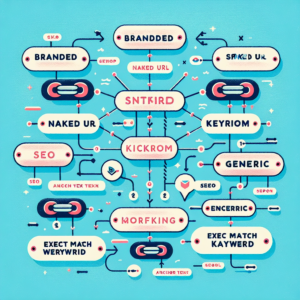Anchor Text is a key element in search engine optimization (SEO), crucial for both site navigation and influencing search engine rankings. It provides context to users and search engines about linked content. Well-crafted anchor texts enhance site usability and boost relevance signals, improving visibility and click-through rates.
Different types of anchor texts can significantly impact SEO strategies. Effective use of anchor text bridges content gaps, enriching user experience and ensuring search engines recognize page relevance. Choosing the right words in anchor texts can improve authority and keyword rankings, vital for better SERP positioning.
Keeping updated with anchor text practices is essential due to evolving search algorithms. Avoiding keyword stuffing and using varied anchor texts help maintain a strong online presence. Proper use of anchor text distributes link equity, enhancing domain authority, and is crucial for long-term SEO benefits.
Anchor text should be relevant and engaging, aiding user engagement and search algorithms. Poorly chosen anchor texts can lead to penalties, making careful selection necessary for maintaining web presence.

Generated with ContentGo AI
Anchor text is the clickable text in a hyperlink, often colored and underlined, that provides context about the linked page. It's crucial for both user experience and search engines, as it helps users identify and navigate links while aiding search engines in understanding the content. For example, "Anchor Text" in a hyperlink indicates relevant information on anchor text. This serves dual purposes: enhancing user navigation and signaling search engines about the linked page's relevance. Proper use of anchor text improves the quality and SEO of your website but must be used ethically to avoid penalties. Diverse and balanced anchor text usage ensures an effective linking strategy.
Anchor text plays a significant role in SEO for several reasons:
Using appropriate anchor texts can lead to better search engine rankings and improved user interaction with your site. It's crucial to select anchor texts that are relevant and informative to both users and search engines. Avoiding generic terms and overly keyword-stuffed anchors can prevent penalties and maintain a natural, user-friendly experience. Consistent, thoughtful use of anchor text not only supports SEO goals but also fosters a more engaging and interactive browsing experience.

Generated with ContentGo AI
Understanding different types of anchor texts can optimize your link-building strategy and enhance SEO efforts. Each type serves specific functions and should be used appropriately:
Exact Match Anchor Text: Uses the exact keyword, e.g., "SEO strategies." It's powerful for relevance but should be used sparingly to avoid penalties.
Partial Match Anchor Text: Includes the keyword with other words, e.g., "best practices for SEO strategies." Balances keyword relevance with natural language use.
Branded Anchor Text: Uses brand names, e.g., "Microsoft." Builds brand recognition and authority, safe from penalties.
Naked Link Anchor Text: Uses URLs as anchors, e.g., "www.example.com." Adds authenticity and transparency.
Generic Anchor Text: Uses common phrases like "click here." Enhances user experience but offers less SEO value.
Diversifying anchor text usage improves both search engine performance and user experience.
This type uses the exact keyword you are targeting, such as "SEO tools." Exact match anchor texts provide clear relevance to both users and search engines, aiding in better understanding and potentially improving rankings. However, it's crucial to use them in moderation to avoid penalties. Ensure the linked content thoroughly covers the keyword topic for a seamless user experience. Diversify your anchor text strategy to maintain a natural link profile and avoid over-reliance on exact matches, which could lead to algorithmic downgrades. Balancing exact match anchors with other types can enhance your SEO efforts effectively.
Anchor text is the clickable text in a hyperlink. Often colored and underlined, it's the visible part that users see and click on a webpage. This text provides both users and search engines with context about the linked page. For instance, in the hyperlink "Check out our Anchor Text guide," the anchor text is "Anchor Text".
Besides being the clickable portion, anchor text also plays a pivotal role in the user experience and SEO strategy. It serves as a navigational tool, guiding users to relevant content and resources across the internet. This clickable text is a key element searched by search engines to determine the context and relevance of the hyperlink, thereby affecting the page ranking in the search results.
The color and style of anchor text often differ from regular text, making it easily identifiable. It is typically underlined and color-coded, usually blue, to distinguish it from non-clickable text. Web designers and developers can customize the appearance of anchor text to align with their website’s design and usability standards. Therefore, ensuring the anchor text stands out can enhance user engagement and navigation on the website, making it a crucial component of the overall web design strategy.
Another interesting aspect of anchor text is its ability to pass link authority from one webpage to another. When a high-authority site links to your webpage with relevant anchor text, it can boost your page’s authority and improve its search engine rankings. Thus, anchor text is not just a visual element but a powerful SEO tool that conveys the value and relevance of links in the digital ecosystem.
Anchor text plays a significant role in SEO for several reasons:
Using appropriate anchor texts can lead to better search engine rankings and improved user interaction with your site.
Firstly, anchor text helps to define the relevance of the linked page. Search engines use this text to analyze the context of the content, ultimately deciding where and how to rank the page. Quality anchor text that accurately describes the linked content can significantly improve the target page's visibility and relevance to searchers.
Secondly, the strategic use of anchor text can influence the ranking of a page. Search engines consider the anchor texts used in inbound links when determining the popularity and authority of a webpage. Well-placed and optimized anchor texts can contribute to higher rankings and better search engine performance.
Lastly, anchor text can enhance the overall user experience on a website. Clear and relevant anchor texts guide users to the content they are interested in, increasing their engagement and time spent on your site. By providing this navigational aid, you can make your website more user-friendly and intuitive, encouraging repeat visits and increased interactions.

Generated with ContentGo AI
Various types of anchor texts serve different purposes. Knowing how to use these can optimize your link-building strategy:
A partial match includes the keyword along with other terms. For instance, "best tools for SEO" is a partial match, which offers a balance between relevance and diversity.
One of the benefits of using partial match anchor texts is that they appear more natural and less spammy than exact match anchors. This helps in maintaining a good user experience and avoids potential penalties from search engines for over-optimization. The diversity in wording also provides nuanced context to search engines, helping them better understand the content.
To effectively use partial match anchor texts, blend the main keyword naturally with other related words. For example, instead of repeating "SEO tips" excessively, you could use "useful SEO tips for beginners" or "advanced SEO tips for professionals." This approach preserves keyword relevance while adding variety and richness to the text.
Moreover, partial match anchor texts can help in targeting long-tail keywords. Long-tail keywords are more specific and often easier to rank for compared to broad keywords. By incorporating these long-tail variations into your partial match anchors, your content can be optimized for a wider range of relevant search queries.
Maintaining a balance in using partial match anchor texts is crucial. Avoid overloading your content with partial matches, as this can still appear manipulative and harm your SEO performance. An effective strategy is to combine partial match anchors with other types of anchor texts to create a well-rounded and natural link profile.
Branded anchors use the name of a brand or company as the anchor. They are safe and effective for establishing brand authority. Example: "Visit Google for more information."
Using branded anchor texts is a common practice in SEO, especially for building brand recognition and trust. When users consistently see a brand name linked in content, it reinforces the brand’s presence and credibility. This can lead to increased brand recall and higher levels of web traffic from users seeking out the brand specifically.
Additionally, branded anchor texts often avoid the risk of over-optimization penalties from search engines. They appear more natural and less keyword-stuffed, which aligns with the preferences of search algorithms that prioritize user-focused content. Brands can use these anchors to link to their homepage, key product pages, or important informational resources, driving traffic to significant parts of their site.
Incorporating branded anchor texts into your SEO strategy also supports brand consistency. It ensures that external links point directly to the right brand entity, avoiding any confusion or misdirection. This is particularly important for businesses with common or highly competitive names, helping them to stand out and remain distinct in search results.
When implementing branded anchor texts, it's essential to ensure they are contextually relevant and placed naturally within the content. Overusing branded anchors can feel promotional and detract from the content’s value. A balanced mix of branded and other types of anchor texts helps maintain a diverse and effective link profile.
Naked links are plain URLs as the anchor text. While they are less frequently clicked by users, they still provide SEO value. For instance: "www.example.com".
Naked link anchor texts, though not visually appealing, still play a role in SEO. These type of links provide a straightforward way to share URLs and ensure that a webpage gets the intended link equity, regardless of the anchor text used. From an SEO perspective, naked URLs can pass authority and improve the linked page’s ranking, based on the quality and relevance of the linking site.
One of the primary uses of naked link anchor texts is in situations where displaying the full URL is beneficial for the user. This could include citing sources, sharing links in forums, or distributing content where clickable text might not be possible. Naked URLs are especially functional in email marketing, print materials, or social media, where the URL needs to be copied and pasted.
Naked links can also offer transparency, showing users exactly where they are being directed. This can enhance trust, particularly in environments where users are cautious about clicking on disguised hyperlinks. Displaying the full URL allows the users to recognize the destination site before clicking.
However, it is important to use naked link anchors judiciously within content. Overuse can make the text look cluttered and reduce readability. Balancing naked link anchors with more descriptive types of anchor texts can provide a cleaner, more readable experience. Additionally, consider using URL shorteners or custom URLs for lengthy addresses, making them more manageable and user-friendly.
Generic anchors use common phrases like "click here" or "read more." While they do not provide much relevance for SEO, they can be useful for user navigation when used sparingly.
Generic anchor texts are simple and commonly used phrases that don't contain specific keywords. While they may not contribute significantly to SEO, they play a role in guiding users through your content, especially for actions like downloads, sign-ups, or more information. Phrases like "click here," "learn more," or "view details" are typical examples.
One advantage of generic anchors is their universality; they are instantly understandable to users, making them ideal for call-to-action buttons or links. These anchor texts encourage users to take a specific action, which can boost engagement metrics such as click-through rates, time on site, and conversion rates.
Although they are not keyword-rich, generic anchor texts can be effectively used when combined with strong contextual content. Ensuring that the surrounding text provides adequate context about the link's destination helps maintain relevance and usability. Despite their simplicity, when strategically placed, generic anchor texts can contribute to a smooth and intuitive navigational experience on your website.
However, over-reliance on generic anchors can diminish the SEO potential of your content. For optimally balanced anchor texts, combine generic anchors with more descriptive types like exact match, partial match, and branded anchors. This diversified approach ensures that while users are guided efficiently, search engines also receive ample context for indexing and ranking your pages appropriately.
Understanding and effectively utilizing Anchor Text is key to a robust SEO strategy. Properly crafted anchor texts can enhance both user experience and search engine optimization, making your site more accessible and valuable to visitors.